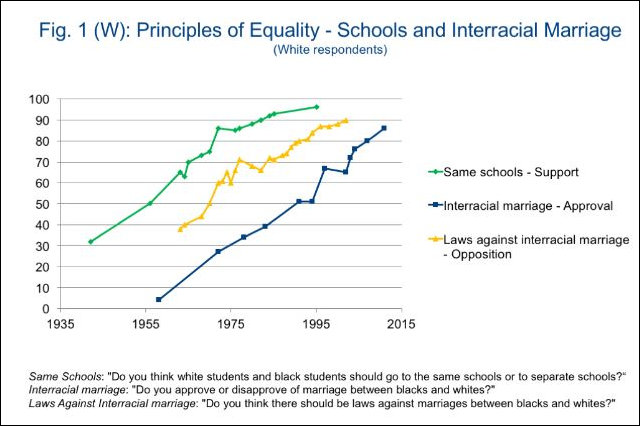By conventional measures of racist attitudes — support for school segregation, opposition to racial intermarriage and the like — white people have become decreasingly racist over time, as seen in the chart above extracted from Gallup organization data and published by the Institute for Government and Public Affairs. Older racists are literally dying out, replaced by young people with egalitarian attitudes.
Yet I don’t remember the preoccupation with race, discrimination and prejudice being so intense since the urban race riots of the late 1960s. Partisan commentators like to blame President Trump, not without some justification, for rhetoric that is racially insensitive or, as they would say, outright racist. But that tells only part of the story. Leftist academics, think tanks, politicians, and media have committed themselves all out to the narrative that not only are Trump and his supporters grievously racist, but so are America and America’s institutions. The bombardment of messages is inescapable. I get reminders in my inbox every day.
The latest missive to provoke my ire comes from the Commonwealth Institute for Fiscal Policy, a Virginia think tank that is mainstream liberal in orientation — not on the lunatic fringe of the left. Today, an email arrived entitled, “Beyond Fiscal Impact Statements: Understanding the Racial Equity Impacts of Public Policy Choices.”
As an example of unintended racial impact, Research Director Loren Goren refers to policies that enhance penalties for distributing drugs within a certain number of feet of a school. Such penalties, she writes, “contribute to longer terms of incarceration and have a disparate impact on people of color. Communities of color generally have more population density and therefore any particular arrest is more likely to be within the school zone.”
As it happens, I have some knowledge of the intersection of drug violence and elementary schools. When I moved in Richmond’s gentrifying Church Hill neighborhood some 30 years ago, I lived a block from Chimborazo Elementary School. I participated in a neighborhood clean-up of the school grounds, cleaning trash and broken glass off the cement playground — not that it made much difference, because I don’t remember kids playing outside very often.
There was a reason for that. Drug-related violence was endemic in the neighborhood. Three people were murdered in a crack house on my block. I recall an incident in which perpetrators on the school grounds shot and wounded three people across the street.
So, who are we supposed to sympathize with? The shooters, on the logic that they operated in a dense urban neighborhood, thus finding it difficult to avoid the schoolyard when conducting their criminal mayhem? Or the school kids, whose recess activities were curtailed due to criminal behavior that ran rampant and uncontrolled at the time? (Things are better now.) I’m sorry, but I fail to see how this is even a question that intelligent people can ask.
Aside from white supremacists representing about one percent of the population, the most race-obsessed people in the United States today are white liberals who are desperate to avoid acknowledging the stupendous failures of welfare policy, K-12 disciplinary policy, the every-family-deserves-to-own-a-house policy, the every-American-deserves-to-attend-college policy, and the myriad other ways in which social justice palliatives have blown up like exploding cigars and made life worse for poor African-Americans. Instead, white liberals double down on the narrative that racism permeates every corner of our society and racists lurk behind every bush. The strategem absolves them of guilt for their failures but it feeds the narrative of African-American victimhood.
White supremacists could not have masterminded policies better designed to fail, demoralize African-Americans, and keep them poor and marginalized.



